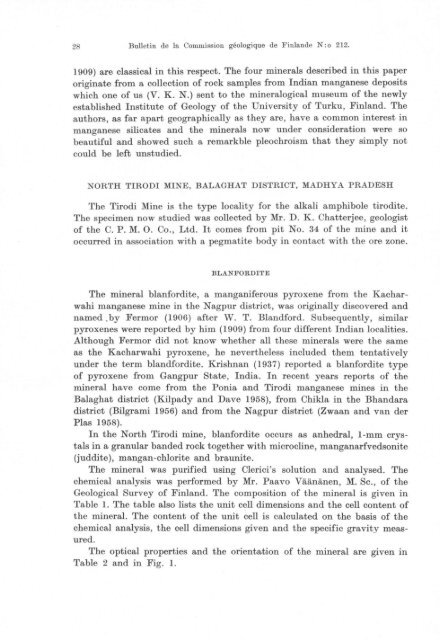COMMISSION GEOLOGIOUE - Arkisto.gsf.fi
COMMISSION GEOLOGIOUE - Arkisto.gsf.fi
COMMISSION GEOLOGIOUE - Arkisto.gsf.fi
You also want an ePaper? Increase the reach of your titles
YUMPU automatically turns print PDFs into web optimized ePapers that Google loves.
28 Bulletin de la Commission geologique de Finlande N: 0 212.<br />
1909) are classical in this respect. The four minerals described in this paper<br />
originate from a collection of rock sampies from Indian manganese deposits<br />
which one of us (V. K. N.) sent to the mineralogical museum of the newly<br />
established Institute of Geology of the University of Turku, Finland. The<br />
authors, as far apart geographically as they are, have a common interest in<br />
manganese silicates and the minerals now under consideration were so<br />
beautiful and showed such a remarkble pleochroism that they simply not<br />
could be left unstudied.<br />
NORTH TIRODI MINE, BALAGHAT DISTRICT, MADHYA PRADESH<br />
The Tirodi Mine is the type locality for the alkali amphibole tirodite.<br />
The specimen now studied was collected by Mr. D. K. Chatterjee, geologist<br />
of the C. P. M. O. Co., Ltd. It comes from pit No. 34 of the mine and it<br />
occurred in association with a pegmatite body in contact with the ore zone.<br />
BLANFORDITE<br />
The mineral blanfordite, a manganiferous pyroxene from the Kacharwahi<br />
manganese mine in the Nagpur district, was originally discovered and<br />
named .by Fermor (1906) after W. T. Blandford. Subsequently, similar<br />
pyroxenes were reported by him (1909) from four different Indian localities.<br />
Although Fermor did not know whether all these minerals were the same<br />
as the Kacharwahi pyroxene, he nevertheless included them tentatively<br />
under the term blandfordite. Krishnan (1937) reported a blanfordite type<br />
of pyroxene from Gangpur State, India. In re cent years reports of the<br />
mineral have co me from the Ponia and Tirodi manganese mines in the<br />
Balaghat district (Kilpady and Dave 1958), from Chikla in the Bhandara<br />
district (Bilgrami 1956) and from the Nagpur district (Zwaan and van der<br />
Plas 1958).<br />
In the North Tirodi mine, blanfordite occurs as anhedral, I-mm crystals<br />
in a granular banded rock together with microcline, manganarfvedsonite<br />
(juddite), mangan-chlorite and braunite.<br />
The mineral was puri<strong>fi</strong>ed using Clerici's solution and analysed. The<br />
chemical analysis was performed by Mr. Paavo Väänänen, M. Sc., of the<br />
Geological Survey of Finland. The composition of the mineral is given in<br />
Table 1. The table also lists the unit cell dimensions and the cell content of<br />
the mineral. The content of the unit cell is calculated on the basis of the<br />
chemie al analysis, the cell dimensions given and the speci<strong>fi</strong>c gravity measured.<br />
The optical properties and the orientation of the mineral are given in<br />
Table 2 and in Fig. 1.
















